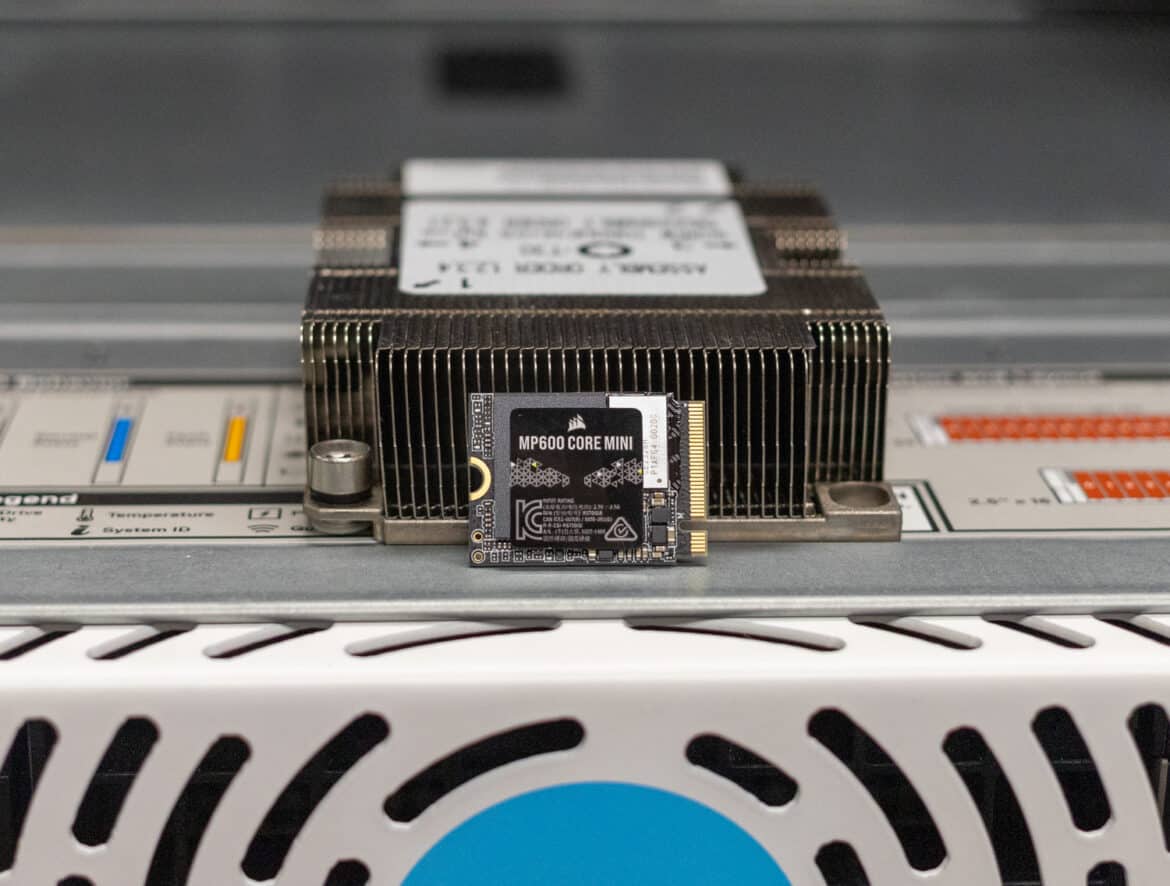We’re seeing a steady increase of options for 2230 form factor SSDs, and Corsair just added another to the list. The Corsair MP600 Core Mini is oriented as a storage upgrade for the Steam Deck, ROG Ally, and Surface Pro as well as other small form factor devices that may utilize a 2230 form factor drive. It may seem obvious, but the MP600 Core Mini is the little brother of sorts, to the MP600 Core which was released back in 2021.
We’re seeing a steady increase of options for 2230 form factor SSDs, and Corsair just added another to the list. The Corsair MP600 Core Mini is oriented as a storage upgrade for the Steam Deck, ROG Ally, and Surface Pro as well as other small form factor devices that may utilize a 2230 form factor drive. It may seem obvious, but the MP600 Core Mini is the little brother of sorts, to the MP600 Core which was released back in 2021.
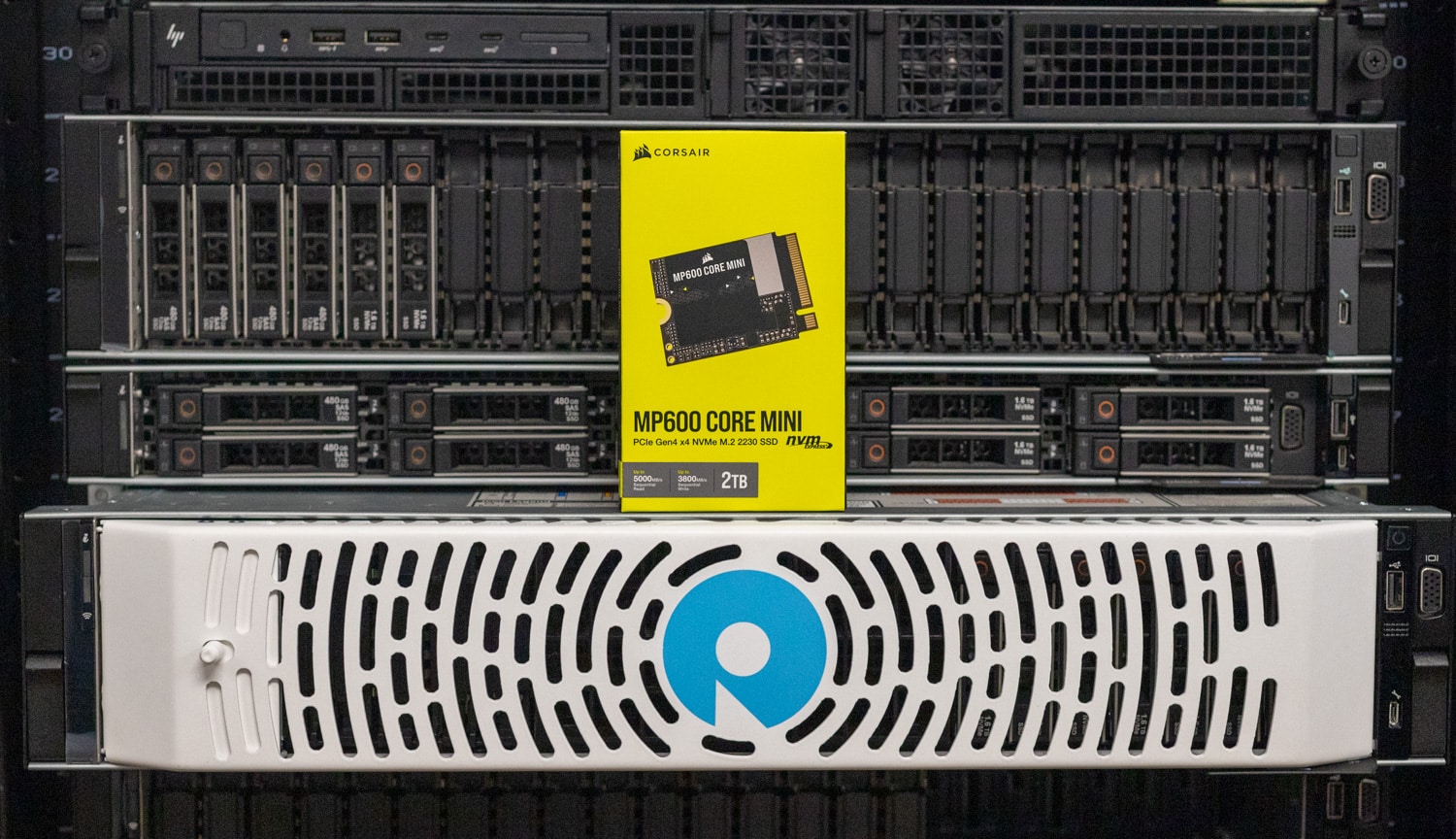
Corsair MP600 Core Mini Specifications
Corsair offers two models of the MP600 Core Mini, 1TB and 2TB models.
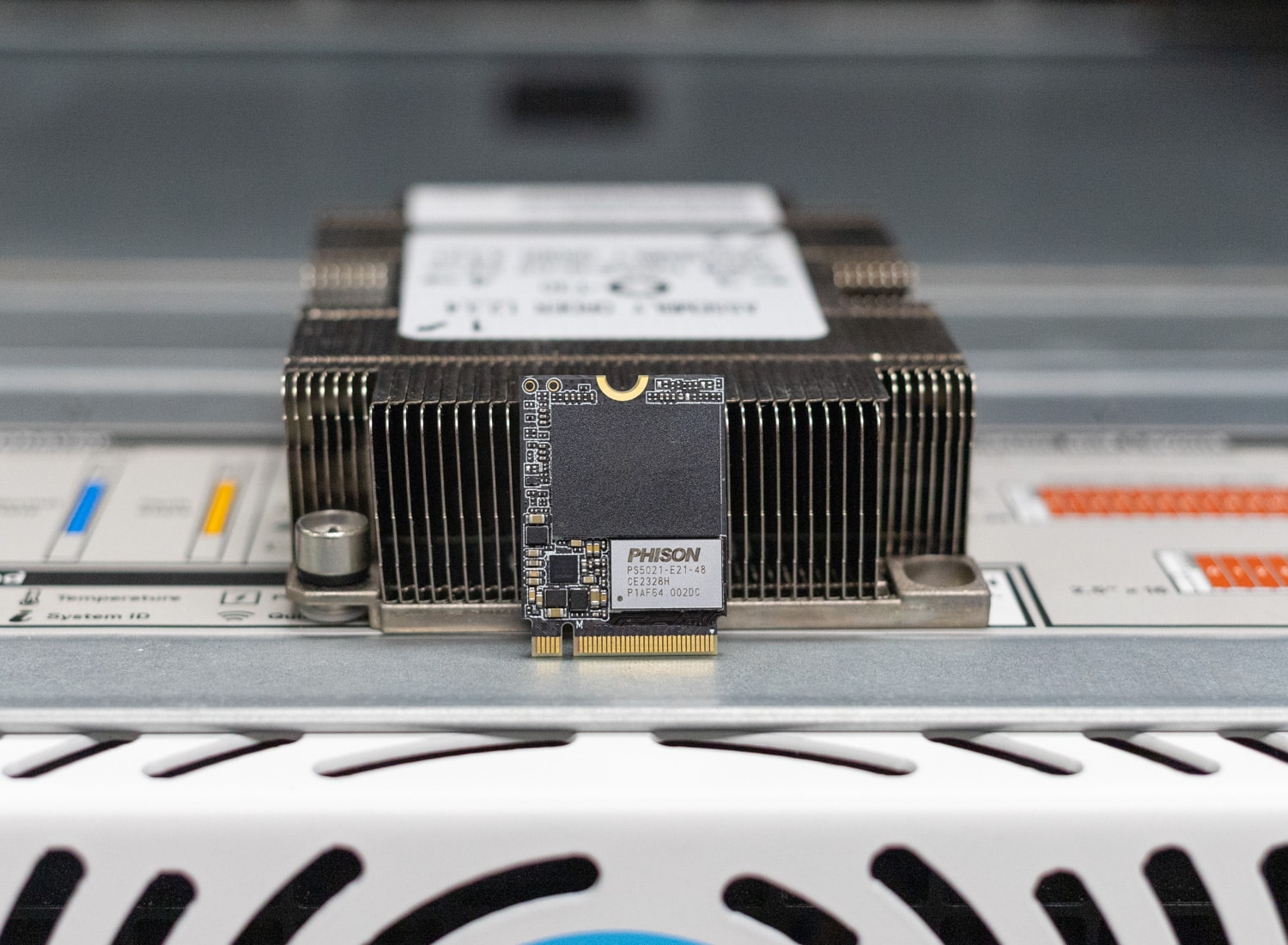
| Model | CSSD-F1000GBMP600CMN | CSSD-F2000GBMP600CMN |
| Capacity | 1000GB | 2000GB |
| NAND | 3D QLC | |
| Controller | Phison PS5021-E21T | |
| Interface | NVME PCIe Gen4x4 | |
| Max Sequential Read | Up to 5000MB/s | |
| Max Sequential Write | Up to 3800MB/s | |
| Random 4KQD32 Read IOPS | Up to 650K | Up to 550K |
| Random 4KQD32 Write IOPS | Up to 900K | Up to 900K |
| Power Consumption R/W | R 4.0/W 3.8 (W) | R 4.1/W 3.9 (W) |
| Form Factor | M.2 2230 | |
| Operating Temperature | 0-70C | |
| MTBF | 1.5 million hours | |
| Shock Resistant | 1500G | |
| Encryption | AES 256-bit | |
| Warranty | 5 years with registration | |
| TBW | 250 | 450 |
Current pricing for the MP600 Core Mini is $94.99 (1TB), and $199.99 (2TB) on Amazon (affiliate links).
Corsair MP600 Core Mini vs Corsair MP600 Core
As mentioned before MP600 Core Mini is like the little brother of the MP600 Core physically, but it does come with a few improvements. The major differences are the Core mini has higher read and write speeds, but it does have lower MTBF and TBW. For being 1/3 the size, the MP600 Core Mini has some impressive gains over its bigger brother. The differences are laid out below.
| MP600 Core Mini vs MP600 Core | ||
| Model | MP600 Core Mini (2023) | MP600 Core (2021) |
| Capacity | 1000GB | 2000GB |
| Form Factor | M.2 2230 | M.2 2280 |
| NAND | 3D QLC | |
| Controller | Phison PS5021-E21T | Phison Ps5016-E16 |
| Interface | NVME PCIe Gen4x4 | |
| Max Sequential Read | Up to 5000MB/s | Up to 4700MB/s |
| Max Sequential Write | Up to 3800MB/s | Up to 1950MB/s |
| Random 4KQD32 Read IOPS | Up to 650K | Up to 200K |
| Random 4KQD32 Write IOPS | Up to 900K | Up to 480K |
| Power Consumption R/W | R 4.0/W 3.8 (W) | R 6.0/W 7.4 (W) |
| MTBF | 1.5 Million hours | 1.8 Million Hours |
| TBW | 250 | 450 |
Corsair MP600 Core Mini Performance
Now to the testing. We have the 2TB variant of the MP600 Core Mini, the 2TB Seagate FireCuda 520N, 2TB WD Black 770M, and 1TB Sabrent 2230 Rocket to put against each other.
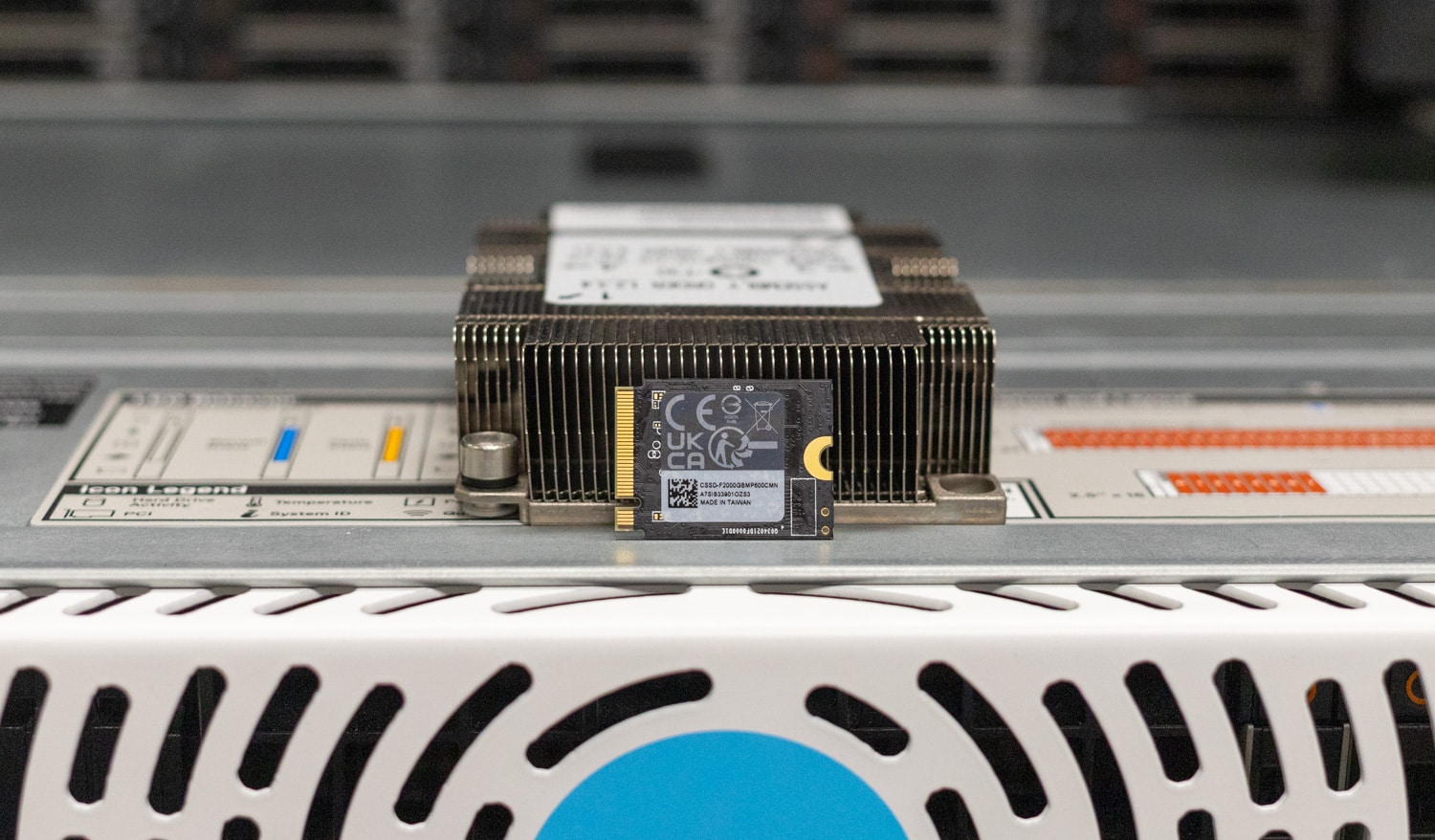
VDBench Workload Analysis
When it comes to benchmarking storage devices, application testing is best, and synthetic testing comes in second place. While not a perfect representation of actual workloads, synthetic tests do help to baseline storage devices with a repeatability factor that makes it easy to do apples-to-apples comparisons between competing solutions. These workloads offer a range of different testing profiles ranging from “four corners” tests, and common database transfer size tests, to trace captures from different VDI environments.
All of these tests leverage the common vdBench workload generator, with a scripting engine to automate and capture results over a large compute testing cluster. This allows us to repeat the same workloads across a wide range of storage devices, including flash arrays and individual storage devices. Our testing process for these benchmarks fills the entire drive surface with data, then partitions a drive section equal to 5% of the drive capacity to simulate how the drive might respond to application workloads. This is different than full entropy tests which use 100% of the drive and take them into a steady state. As a result, these figures will reflect higher-sustained write speeds.
Profiles:
- 4K Random Read: 100% Read, 128 threads, 0-120% iorate
- 4K Random Write: 100% Write, 64 threads, 0-120% iorate
- 64K Sequential Read: 100% Read, 16 threads, 0-120% iorate
- 64K Sequential Write: 100% Write, 8 threads, 0-120% iorate
- Synthetic Database: SQL and Oracle
- VDI Full Clone and Linked Clone Traces
Random and Sequential Read/Write tests
We start with Random Read 4K, Where the MP600 Core Mini topped out at 51,082 IOPS and 7,656µs, ahead of the Firecuda 520N which topped at 28,791 IOPS and 6,813µs. In this test, the Sabrent 2230 Rocket performed the best reaching 309,092 IOPS with the WD Black 770M in a far second with 102,156 IOPS but still a good distance ahead of the MP600 and Firecuda. The biggest contributor to these performance differences seems to fall on the usage of QLC NAND for the MP600 and Firecuda vs the TLC used on the Sabrent and WD drives.
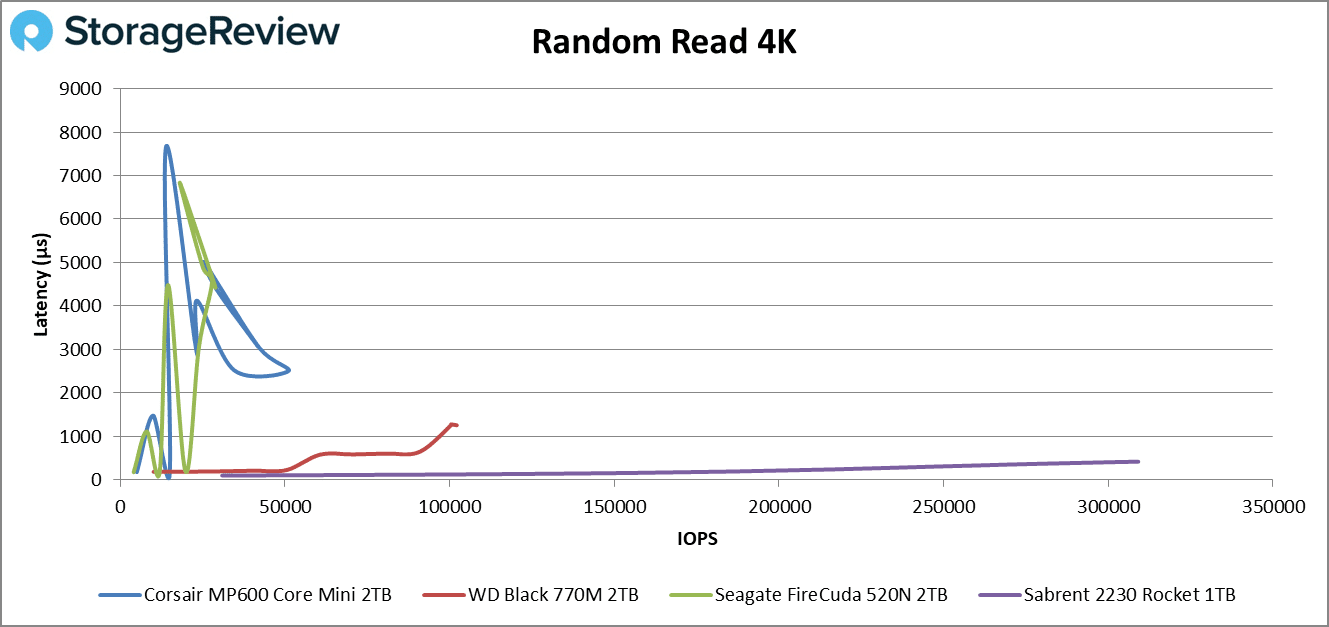
Next is Random Write 4k, where the MP600 peaks at 7,380 IOPS and 7,380µs and the Firecuda got 7,791 IOPS so the results are on top of each other here. These two drives performed fairly stable on the slower write, but then the Rocket and WD became unstable. The WD got 38,797 IOPS at its peak speeds and the Sabrent hit 100,342 IOPS.
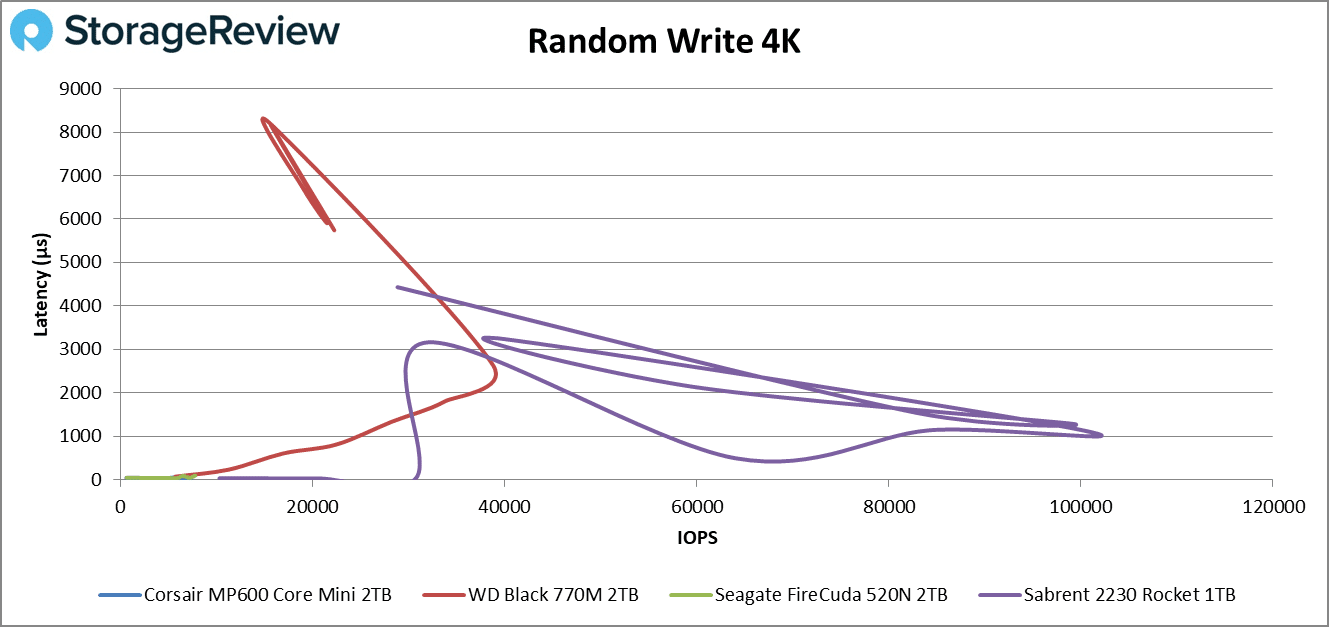
In the Sequential Read 64k test, We see steady results again from the Rocket and WD drives just barely passing 500µs of latency. The MP600 and Firecuda are right next to each other again with their throughput getting 981MB/s and 1,075MB/s respectively but at a higher latency with both hovering around 2100µs.
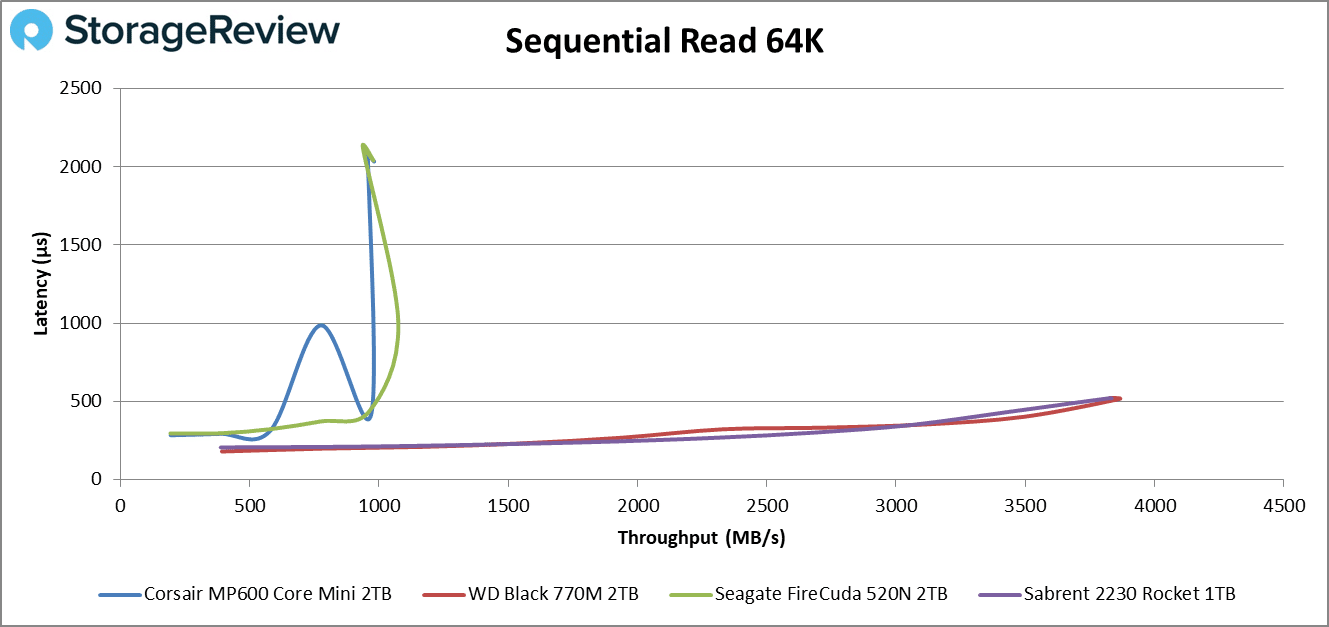
For Sequential Write 64k, The MP600 and Firecuda were pretty close again with both drives getting 123MB/s but the MP600 hitting 8,092µs of latency, and the Firecuda getting 6,634 µs. We see a little bit of instability on WD and Rocket drives but better than the other two. The WD made 318MB/s peaking at 3263µs and the Rocket made 996MB/s with only 1,619µs of latency.
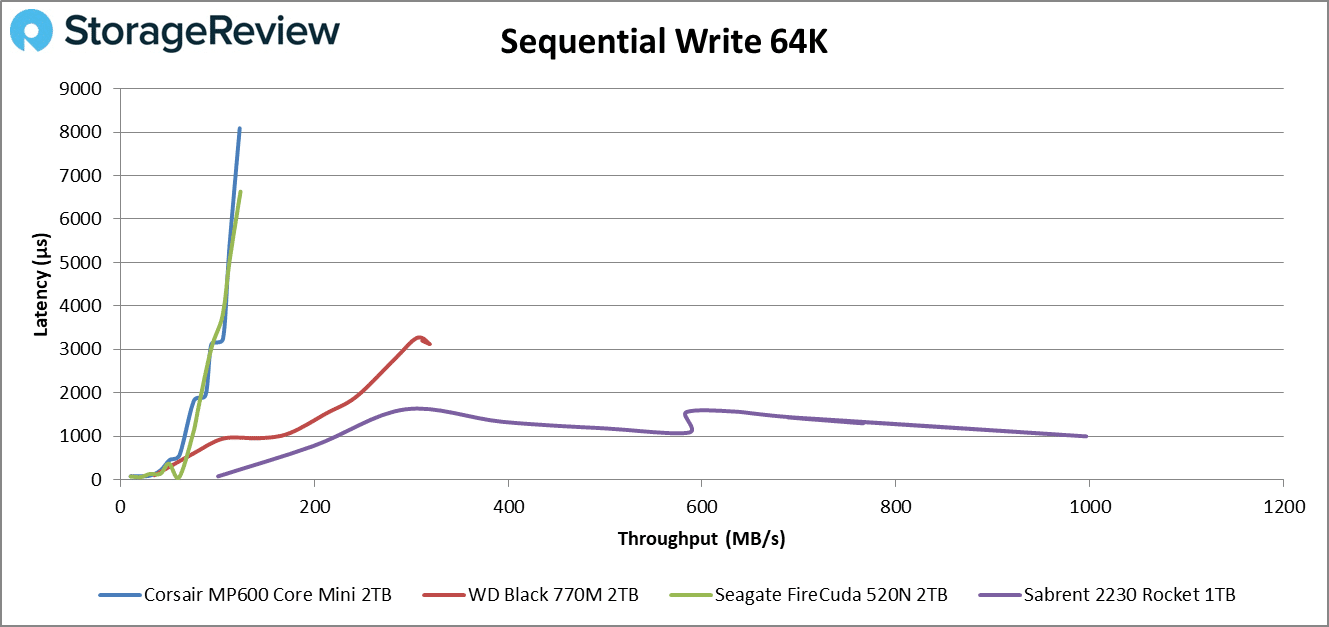
VDI Tests
For the VDI Boot test, the MP600 and Firecuda were all over the board but making 16,176 IOPS and 15,164 IOPS respectively. Latency-wise, the MP600 hit 3,888µs and the Firecuda hit 4,167µs The WD freaked out a little but stayed mostly stable making 41,686 IOPS at a max of 1,581µs but still behind the Rocket. The Rocket made 59,038 IOPS here at 579µs.
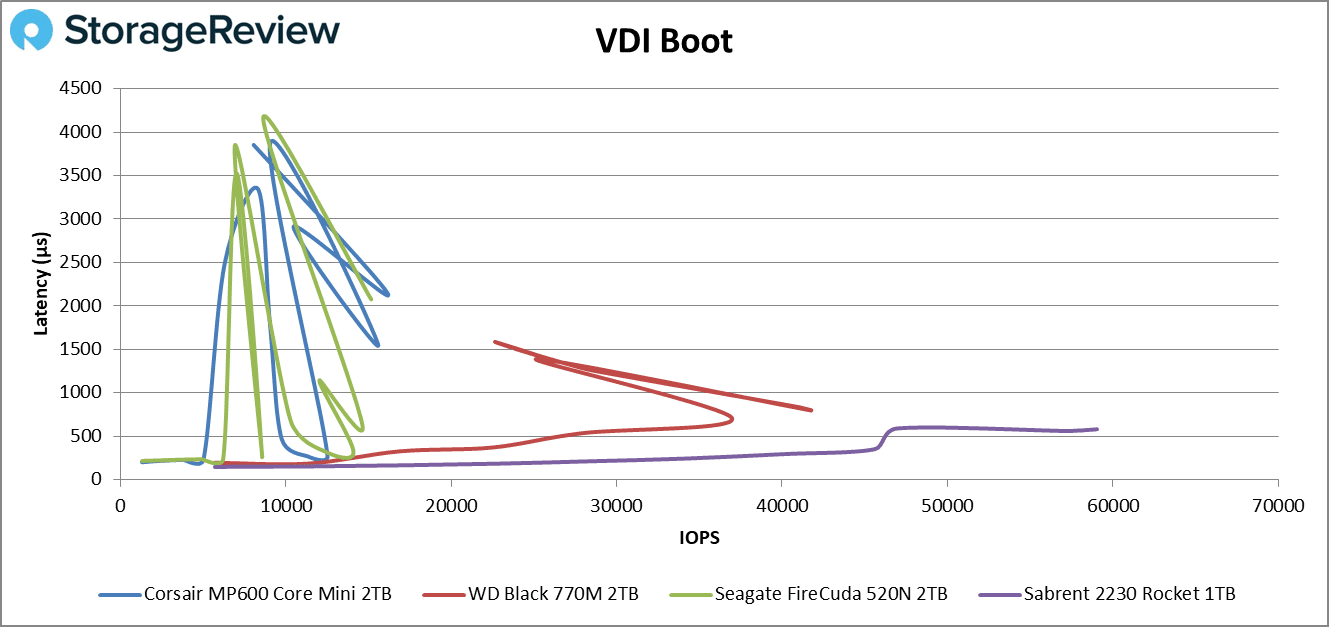
For VDI Initial Login, the results are all over the board, but surprisingly the MP600 and Firecuda pulled ahead of the WD but still behind the Rocket. The MP600 made 15,384IOPS at 3,684µs and the Firecuda fell back at 14,491 IOPS and 5,812µs. Surprisingly the WD fell back only making 7,892 IOPS but only hit 3,230µs. And the Rocket held as the fastest at 18,070 IOPS and only 3,128µs of latency.
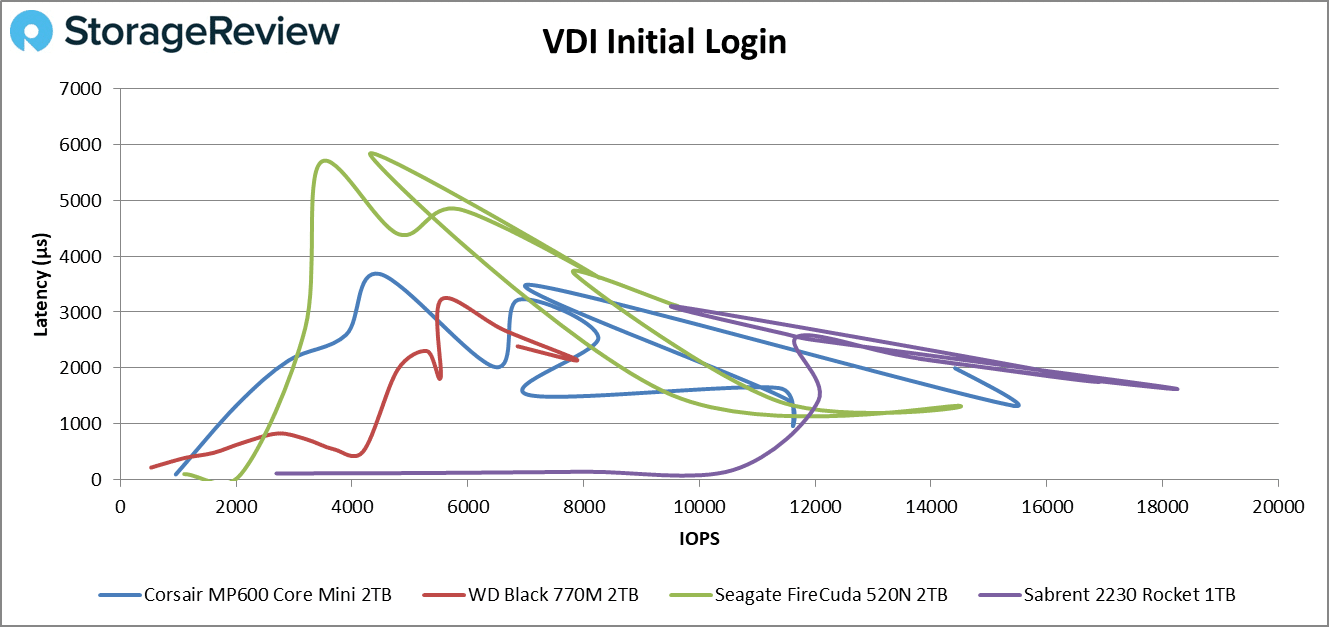
The Last test is VDI Monday Login, where the MP600 did hit the highest latency at 2419µs but passed all of the other drives with 12,503 IOPS. Performing pretty closely was the Firecuda with 12,407 IOPS and 1,775µs. Next was the Rocket with 11,203 IOPS and 1,569µs pulling just faster than the WD drive. Finally, the WD made 11,125 IOPS and 2,066µs.
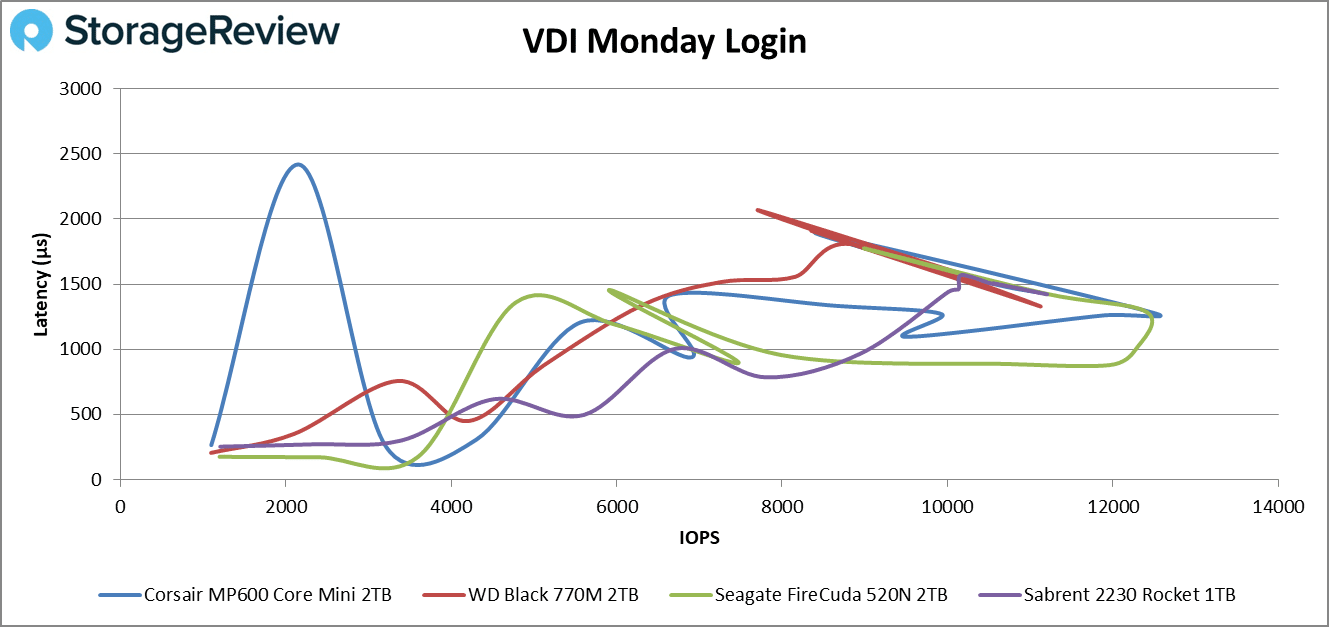
Conclusion
Overall, if you’re looking for a well-performing QLC 2230 drive, the MP600 Core Mini does okay. The MP600 and Firecuda 520N performed pretty closely but ultimately, the MP600 Core Mini pulled ahead. Both of these drives use QLC and the same E21T Controller so the numbers do make sense.
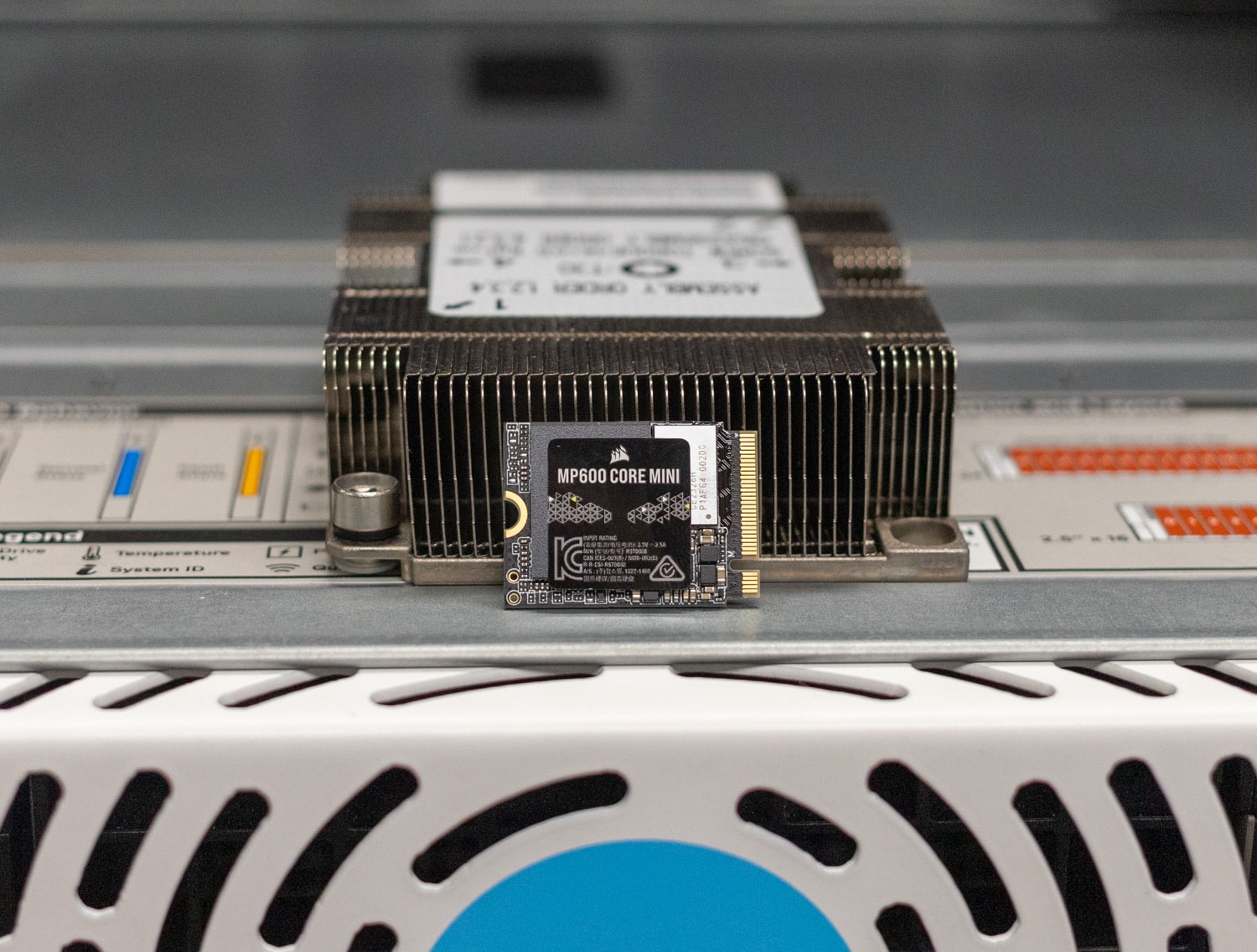
At the end of the testing, these four drives highlighted the performance differences between TLC and QLC NAND pretty well. Sweetening the deal a little bit, Corsair backs the MP600 Core Mini with a 5-year warranty in case you run into issues. At current market pricing, this drive doesn’t exactly fit into the bang for your buck category since it is in the same price bracket as the Sabrent. If Corsair pulls these prices down in the future though, this drive would make a nice budget alternative to its TLC counterparts.
Engage with StorageReview
Newsletter | YouTube | Podcast iTunes/Spotify | Instagram | Twitter | TikTok | RSS Feed

